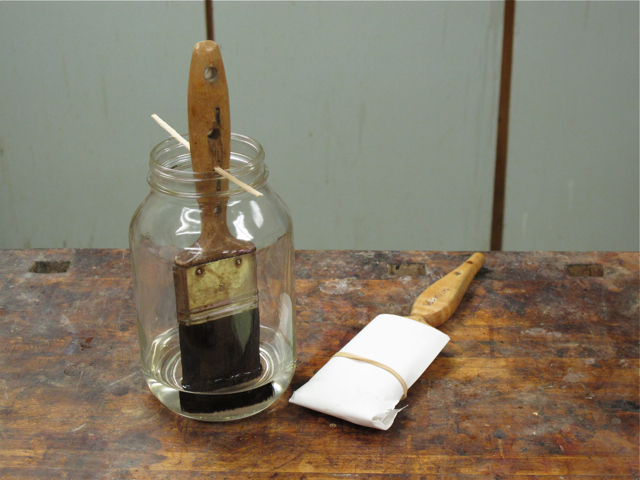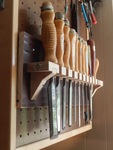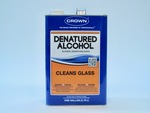We may receive a commission when you use our affiliate links. However, this does not impact our recommendations.

Store a shellac brush short term by hanging it in some denatured alcohol. Store the brush long term by washing it in half-and-half household ammonia and water, then soap and water, then shake it out and wrap it in paper to dry.
I know that a lot of readers use shellac for finishing. Of all finishes, shellac is probably the easiest to use when it comes to cleaning and storing brushes because shellac dissolves easily in denatured alcohol and household ammonia. Here are some suggestions of ways to clean and store shellac brushes.
If you plan to use the brush again within a day or two, say to apply an additional coat of shellac, simply hang it in some denatured alcohol. The easy way to do this is with a dowel rod or stick running through the hole in the handle to keep the bristles from becoming bent at the bottom of the container. You may need to drill a new hole closer to the bristles unless you’re using a tall container. Just before using the brush again, shake it out to remove most of the alcohol.
You don’t need to completely cover the bristles with the alcohol because it will wick up the bristles.
If you don’t intend to use the brush again soon, but will always use it with shellac, dip the brush into denatured alcohol and press it to the bottom of the container several times to remove most of the shellac. Then shake out the brush and wrap it in the holder it came in or in paper with a rubber band or masking tape to secure the paper. You could skip the alcohol dip, but this will cause the next step to take longer.
Before the next use, soak the brush in alcohol to dissolve the shellac and soften the bristles. Then shake the brush out to remove most of the alcohol so you don’t over-thin the shellac during the first few brush strokes.
The downside of this method is that you have to wait for the bristles to soften before using the brush, and this could take awhile unless most of the shellac has already been removed with alcohol.
If you don’t intend on using the brush again for several days, or if you may want to use it with a different finish, you can clean the brush faster and more thoroughly by dipping it in about half household ammonia and water. Again, press the brush several times against the bottom of the container to be more effective. Then wash the brush with soap and water to remove any remaining shellac and residue ammonia. Finally, wrap the brush in its original holder or paper, and store the brush in a drawer or hang it on a hook.
The downside of this method is that it will take several days for the water to dry out of the brush, so you won’t be able to use it right away with any finish except a water-based finish, or the finish may blush (turn milky white).
I typically use the ammonia-and-water method unless I plan on using the brush again within the next couple of days, in which case I simply hang the brush in a jar with a little denatured alcohol.
Here are some supplies and tools we find essential in our everyday work around the shop. We may receive a commission from sales referred by our links; however, we have carefully selected these products for their usefulness and quality.









